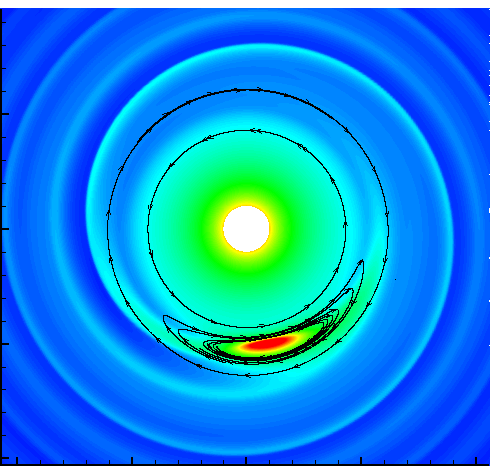Rossby Wave Instability on:
[Wikipedia]
[Google]
[Amazon]
 Rossby Wave Instability (RWI) is a concept related to astrophysical
Rossby Wave Instability (RWI) is a concept related to astrophysical
 Rossby Wave Instability (RWI) is a concept related to astrophysical
Rossby Wave Instability (RWI) is a concept related to astrophysical accretion disc
An accretion disk is a structure (often a circumstellar disk) formed by diffuse material in orbital motion around a massive central body. The central body is most frequently a star. Friction, uneven irradiance, magnetohydrodynamic effects, and ...
s. In non-self-gravitating discs, for example around newly forming stars, the instability can be triggered by an axisymmetric bump, at some radius , in the disc surface mass-density. It gives rise to exponentially growing non-axisymmetric perturbation in the vicinity of consisting of anticyclonic
A high-pressure area, high, or anticyclone, is an area near the surface of a planet where the atmospheric pressure is greater than the pressure in the surrounding regions. Highs are middle-scale meteorological features that result from interpl ...
vortices. These vortices are regions of high pressure and consequently act to trap dust particles which in turn can facilitate planetesimal growth in proto-planetary discs. The Rossby vortices in the discs around stars and black holes
A black hole is a massive, compact astronomical object so dense that its gravity prevents anything from escaping, even light. Albert Einstein's theory of general relativity predicts that a sufficiently compact mass will form a black hole. Th ...
may cause the observed quasi-periodic modulations of the disc's thermal emission.
Rossby wave
Rossby waves, also known as planetary waves, are a type of inertial wave naturally occurring in rotating fluids. They were first identified by Sweden-born American meteorologist Carl-Gustaf Arvid Rossby in the Earth's atmosphere in 1939. They ...
s, named after Carl-Gustaf Arvid Rossby
Carl-Gustaf Arvid Rossby ( 28 December 1898 – 19 August 1957) was a Swedish-born American meteorologist who first explained the large-scale motions of the atmosphere in terms of fluid mechanics. He identified and characterized both the jet ...
, are important in planetary atmospheres and oceans and are also known as planetary waves
Rossby waves, also known as planetary waves, are a type of inertial wave naturally occurring in rotating fluids. They were first identified by Sweden-born American meteorologist Carl-Gustaf Arvid Rossby in the Earth's atmosphere in 1939. They a ...
. These waves have a significant role in the transport of heat from equatorial to polar regions of the Earth. They may have a role in the formation of the long-lived ( yr) Great Red Spot
The Great Red Spot is a persistent high-pressure area, high-pressure region in the atmosphere of Jupiter, producing an anticyclonic storm that is the largest in the Solar System. It is the most recognizable feature on Jupiter, owing to its red-o ...
on Jupiter
Jupiter is the fifth planet from the Sun and the List of Solar System objects by size, largest in the Solar System. It is a gas giant with a Jupiter mass, mass more than 2.5 times that of all the other planets in the Solar System combined a ...
which is an anticyclonic
A high-pressure area, high, or anticyclone, is an area near the surface of a planet where the atmospheric pressure is greater than the pressure in the surrounding regions. Highs are middle-scale meteorological features that result from interpl ...
vortex. The Rossby waves have the notable property of having the phase velocity
The phase velocity of a wave is the rate at which the wave propagates in any medium. This is the velocity at which the phase of any one frequency component of the wave travels. For such a component, any given phase of the wave (for example, t ...
opposite to the direction of motion of the atmosphere or disc in the comoving frame of the fluid.
The theory of the Rossby wave instability in accretion discs was developed by Lovelace et al. and Li et al. for thin Keplerian disc
Johannes Kepler (27 December 1571 – 15 November 1630) was a German astronomer, mathematician, astrologer, natural philosopher and writer on music. He is a key figure in the 17th-century Scientific Revolution, best known for his laws of p ...
s with negligible self-gravity and earlier by Lovelace and Hohlfeld for thin disc galaxies where the self-gravity may or may not be important and where the rotation is in general non-Keplerian.
The Rossby wave instability occurs because of the local wave trapping in a disc. It is related to the Papaloizou and Pringle instability; where the wave is trapped between the inner and outer radii of a disc or torus.
References
Further reading
* {{cite journal , doi=10.1088/0169-5983/46/4/041401, arxiv = 1312.4572 , bibcode = 2014FlDyR..46d1401L , volume=46 , title=Rossby wave instability in astrophysical discs , journal=Fluid Dynamics Research , pages=041401, year = 2014 , last1 = Lovelace , first1 = R V E. , last2 = Romanova , first2 = M. M., author2-link=Marina Romanova , issue = 4 , s2cid = 118504602 Astrophysics